Introduction
From 1934 onwards Jaguar used Champion spark plugs for their pre-war (SS) engines. This may also have influenced them to source spark plug caps (or HT cable terminals) from Champion after the war.
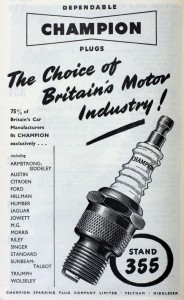 Advertisement 1951, mentiones Jaguar
Advertisement 1951, mentiones Jaguar
History of Champion in UK
Champion started it spark plug activities in 1908 in Boston, USA and then moved to Toledo, Ohio, USA in 1910. In 1920 Champion moved across the Atlantic and established the Champion Sparking Plug Company Ltd. in England with their offices at 83, Pall Mall, London. Their UK industrial facilities were at Hatton Cross, Feltham, Middlesex (near London) and stayed there until it had to move due to the extension of Heathrow Airport in 1968. Thereafter the Champion Spark Plug Company operated an automotive components factory on Arrowe Brook Road, Upton near Liverpool employing at one time over 1,000 people. It was closed in 2006 and the production was transferred to Italy.
Early spark plug terminals: Jaguar C404
Pre-war and first post-war models like the Jaguar MK IV and MK V used an uninsulated horizontally positioned terminal made of tempered (tinned) brass (Jaguar part number C404), which was secured by a nut on the threaded end of the spark plug. The manufacturer of these terminals is unknown.
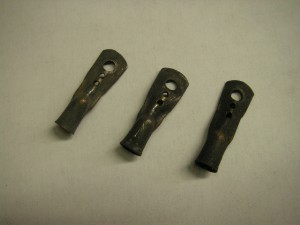 Early spark plug terminal C404 (Courtesy Rob Reilly)
Early spark plug terminal C404 (Courtesy Rob Reilly)
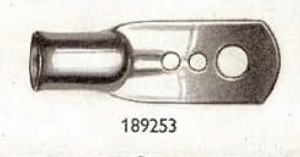 Lucas HT terminal end 189253
Lucas HT terminal end 189253
Lucas HT terminal end 189253 for 7 mm cable seems identical to Jaguar C404 and we may conclude that these were supplied by Lucas.
Note that all XK engines as used for the XK120, 140 and 150 had “straight” spark plug caps, apart perhaps from some early (experimental) engines that had horizontal connections for the HT wires.
Jaguar C1575: uninsulated straight terminal
The early Jaguar XK 120 (up to engine number W6372; late October 1952) had a spark plug terminal Jaguar part number C1575, which is in fact an uninsulated straight metal sleeve connected to the HT wire. This method of fastening the HT cable to the spark plug terminal is different from all later systems: the copper core of the HT cable was mechanically connected to the brass sleeve that fits over the spark plug end.
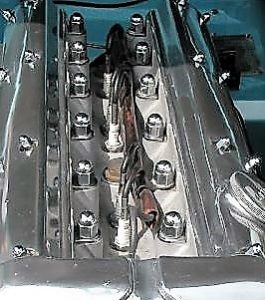 C1575 uninsulated straight terminal
C1575 uninsulated straight terminal
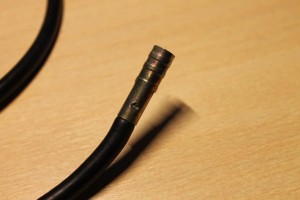 Example of an uninsulated straight spark plug terminal
Example of an uninsulated straight spark plug terminal
Up to November 1952 XK 120’s had a distributor cap (Lucas 415708) with horizontal cable outlets: the HT leads entered through holes on the side and had a screw on the inside that fastens down on the leads. So the early HT cables had a metal sleeve at one end and nothing at the other end.
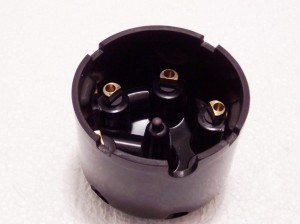 Lucas 415708 for early XK 120
Lucas 415708 for early XK 120
Jaguar C5479: Champion HTC cap
From late October 1952 onwards the XK120 received a spark plug cap made by (or made for) Champion. Jaguar changed over to an insulated (Bakelite) spark plug cap type replacing the bare metal C1575. The original early version (that we know now as the Champion HTC type) had tiny embossed letters on the rim in the middle: “Champion Made in England”. They have an internal, fixed screw tip and are screwed into the centre core of the HT wire ends.
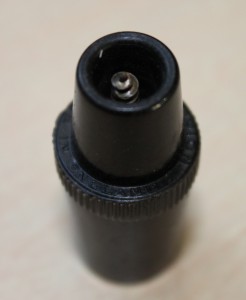 Text “Champion Made in England”
Text “Champion Made in England”
This Champion plug cap was used on the later XK120, XK140 and XK150, unless a suppressor plug cap was required (see hereafter).
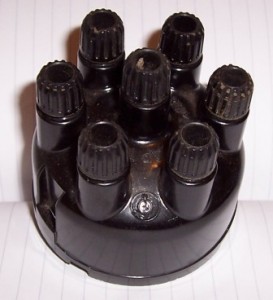 Lucas 407043 for later XK 120
Lucas 407043 for later XK 120
About the same moment the fastening system with “moulded nut and split-washer” for the HT wires to the distributor cap was introduced (late November 1952) when the XK changed over to a distributor cap with vertical entry (Lucas 407043) and a different routing for the HT cables. So both ends of the HT cable got new “terminals”.
Later Champion HTC 2 plug caps (replacement for original)
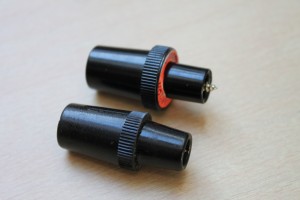 Difference between original and new HTC 2
Difference between original and new HTC 2
A new HTC version was introduced in the 70’s. These are slightly larger in diameter, have a wider knurled ring and the embossing (Made in England) has been replaced by an initially grey and later red printed paper ring with two times “Champion” on it. Apart from the missing embossing, the newer versions can be easily recognised as the black housing has less taper at the plug end, whereas the other end has almost no taper at all. Both are of the same length but the pin that screws into the HT Cable core protrudes further in case of the newer versions (see photo above).
As mentioned above, there are two basic productcversions: the original and the replacement version. The latter can be divided in the initial “Grey ring” version followed by the “Red ring” version. The difference is also shown in the boxes that belong to two later replacement versions:
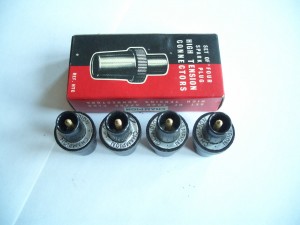
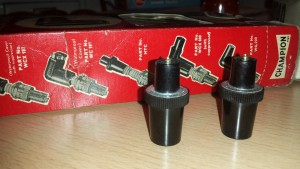 “Grey paper ring” box with description “REF. HTC” or “Part No. HTC”
“Grey paper ring” box with description “REF. HTC” or “Part No. HTC”
Early versions had a Grey paper ring and can be recognized by the “slotted” screw for connecting the cable core, that can be seen on the inside of the metal part that snaps over the spark plug. Note the text on the box “spark plug high tension connectors Ref. HTC”. We may conclude from this that the early “grey ring” version was still called HTC instead of HTC2.
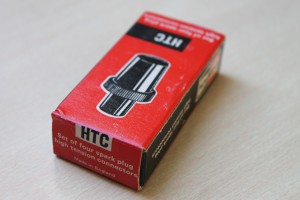
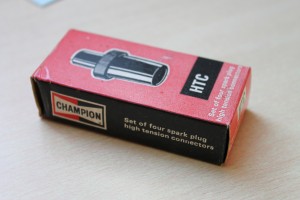 Box for later “Red paper ring” versions with model number “HTC”
Box for later “Red paper ring” versions with model number “HTC”
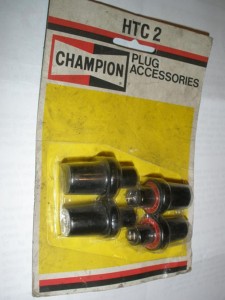 Blister with “HTC-2” spark plug caps
Blister with “HTC-2” spark plug caps
Note that the “Red paper ring” version is not named HTC-2 on the box. These later Red paper ring versions can be recognized by the “crosshead” screw on the inside of the metal part that snaps over the spark plug.
Alternative Champion HTC cap with fixing screw
Another Champion “HTC cap type” that occasionally comes for sale, has a fixed, internal brass piece into which the exposed lead wire end is fitted and then held in place with a set screw. This version was applied by BMC (part number AEC 388). The mould used for the Bakelite housing is apparently the same as for the initial HTC cap as the embossing (Made in England) is identical.
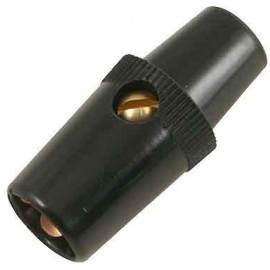
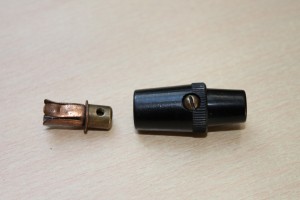 HTC with screw
HTC with screw
As far as we know this version was never used by Jaguar.
Jaguar C.8306 Lucas 78113A spark plug suppressor cap
With the arrival of TV in the early 1950’s in the UK (and elsewhere of course) the need for a “suppressor” version arose. Initially the Lucas type WS5 spark plug cap could be installed as “optional” and wasn’t applied as the “standard” plug cap.
Service Bulletin SB131 (dated August 1953) however had the following information: Note that all Home Market and Home leave cars are now fitted with ignition suppressors. So we may conclude from this that the majority of the exported cars still had the Champion HTC spark plug cap installed.
The 1960 XK150 SPC clearly states that the C.8306 spark plug suppressor cap was now installed on all Export versions. The exact implementation date is as yet unknown, but probably in the period 1957 – 1959.
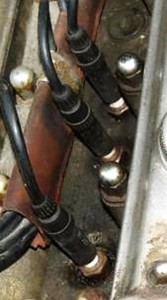
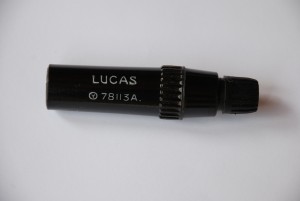 Suppressor Lucas 78113A (photo: Roger Payne) Lucas 78113A has resistance of about 18 kΩ
Suppressor Lucas 78113A (photo: Roger Payne) Lucas 78113A has resistance of about 18 kΩ
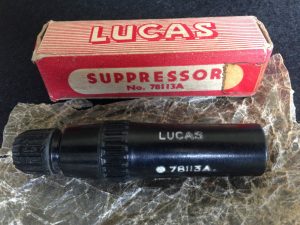
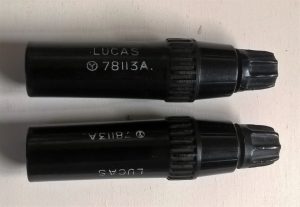 Lucas suppressor 78113A in original box Two versions of 78113A with text 180 degree rotated
Lucas suppressor 78113A in original box Two versions of 78113A with text 180 degree rotated
The resistance of this Lucas suppressor is about 18 kΩ. The HT lead connection is similar to the distributor cap installation with “moulded nut and split washer”. Note that there are two different versions of this suppressor whereby the text has been rotated 180 degrees. The part number itself did not change. The photo above left is identical to the bottom version on the photo right and is probably the first generation: the font is smaller and it smells like “Bakelite”.
For older cars with an uninsulated brass terminal secured by a nut on the threaded end of the spark plug, Lucas introduced a special suppressor 78107A . After the existing nut has been removed, this suppressor is positioned on the spark plug (either horizontally or vertically) and the nut is placed back. The brass terminal of the plug cable is attached to the other end of the suppressor.
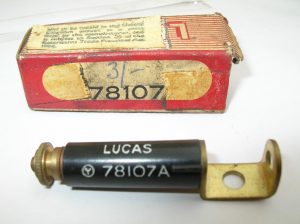 Lucas suppressor 78107A for earlier cars
Lucas suppressor 78107A for earlier cars
Other types of suppressors
As mentioned above, most XK’s left the factory with Champion plug caps without suppressor. The XK120 Spare Parts Catalogue, however, refers to Suppressor C8046 installed on the Distributor Cap of all Home Market XK120s in addition to the Plug Suppressors C8306. Reference is made of Suppressor C8046 (Lucas 78114A) described as an alternative solution for the Lucas 78113A spark plug suppressor cap . This single suppressor, with a resistance of about 10 to 15 k Ω, is positioned in the centre connection of the distributor cap. In this way the spark from the coil is suppressed before it enters the distributor cap. A warning is given not to install this suppressor in the connector of the ignition coil: “If fitted to the coil (instead of the distributor cap) there will be a ¼”gap causing ignition failures”
A second version of this distributor cap mounted suppressor is Lucas 78120A which is identical to Lucas 78114A however with a lower resistance of 6.3 k Ω.
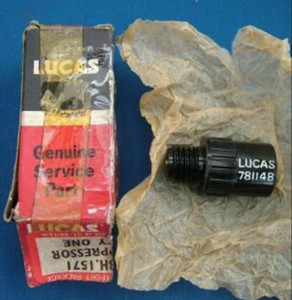 Suppressor C8046 for centre contact distributor cap.
Suppressor C8046 for centre contact distributor cap.
Identical cap-mounted suppressors (but also many other suppressor types) have been manufactured by Erie Resistor Ltd of Great Yarmounth (UK). The Erie D8 is an exact copy of the Lucas 78120A suppressor which may lead to the conclusion that Erie actually manufactured these for Lucas.
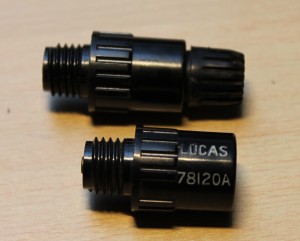 Lucas 78120A with identical Erie D8 (with nut) above
Lucas 78120A with identical Erie D8 (with nut) above
There were a number of other companies supplying the same suppressor, like Durite and SIRAN. Durite was a British manufacturer of automotive electrical equipment. SIRAN Accessories was a 1960’s British company based in Hove, known for its car instruments and switches. Resistance values are unknown.
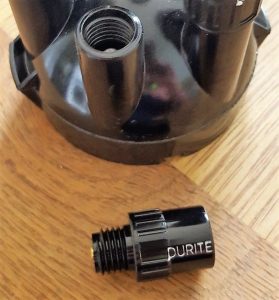
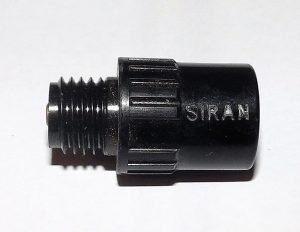 Suppressor supplied by Durite Same suppressor now branded SIRAN
Suppressor supplied by Durite Same suppressor now branded SIRAN
Another version was the “cable type of suppressor” as e.g. Lucas 78105A. This type is normally placed in the cable from HT Coil to Distributor cap and is screwed in the copper core of the HT lead. But it is sometimes used in every spark plug lead.
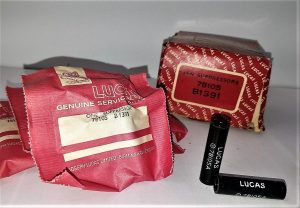
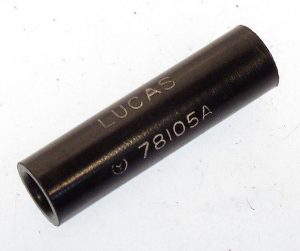 Lucas cable type suppressor 78105A
Lucas cable type suppressor 78105A
The Erie Resistor Lid. also provided a cable suppressor (probabale code number WAD.1738) with 5000 Ω resistance. An example is shown below with a suppressor in all 6 HT leads.
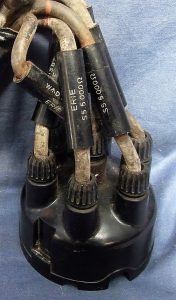 Erie Cable type suppressor of 5 kΩ
Erie Cable type suppressor of 5 kΩ
In May 1957 Jaguar Saloons received a new DMBZ distributor with a distributor cap with “built-in suppressor”. Reference is made of Service Bulletin No. 212 of May 1957 which states: ” Note that the DMBZ type of distributor fitted to the above models incorporates an inbuilt suppressor. The suppressor normally fitted in the centre terminal post of the distributor is therefore unnecessary and must not be fitted.” The centre terminal post suppressor as refered to is the above described Lucas 78114A (or Lucas 78120A version).